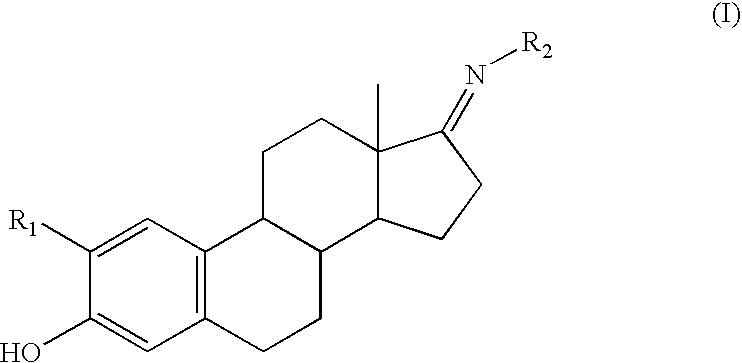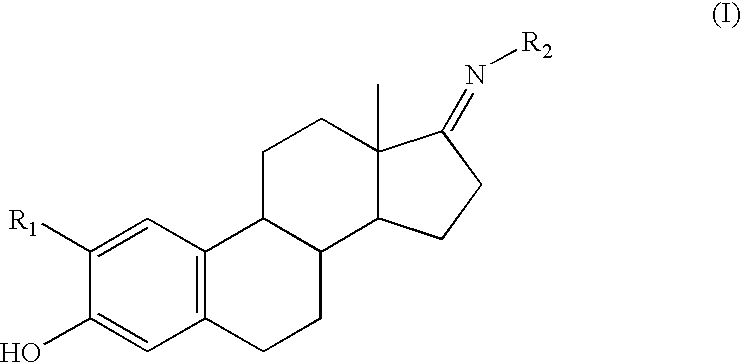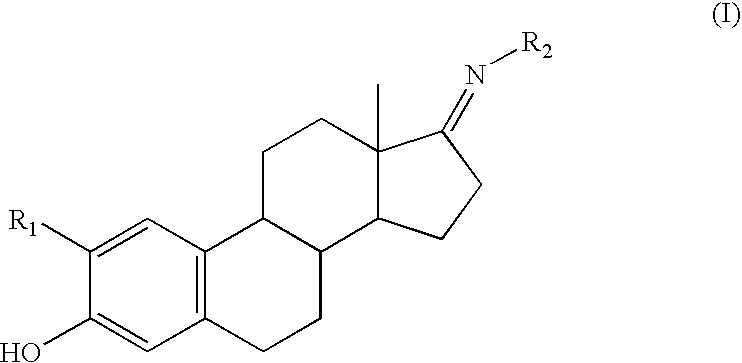Compounds and methods for cytoprotection
a cytoprotective steroid and compound technology, applied in the field of new cytoprotective steroid classes, can solve the problems of unfavorable degenerative diseases, large social costs, and undesirable compromised cellular activity,
- Summary
- Abstract
- Description
- Claims
- Application Information
AI Technical Summary
Benefits of technology
Problems solved by technology
Method used
Image
Examples
example 1
Synthesis of a Representative Compound of Structure (I)
[0098]
Synthesis of Compound No. 2
[0099]To a stirred suspension of estrone (compound no. 1) (1.08 g) and 1-adamantanol (0.70 g) in hexane (30 ml) at 0° C. under an argon atmosphere was added BF3·Et2O (1.6 ml) dropwise via a syringe. The mixture was stirred and allowed to warm to room temperature over a period of 4 hours. The solvent was then removed under vacuum. The residue was titrated with water. The resulting solid was collected by filtration and recrystallized from a mixed solvent of ethyl acetate and hexane to yield compound no. 2 as a white solid (0.792 g). 1H NMR (CDCl3) d=7.14(s, 1H), 6.41(s, 1H), 4.68(s, 1H), 2.81(m, 2H), 2.48(m, 2H), 2.25(m, 2H), 2.0-10(m, 8H), 1.95(m, 2H), 1.77(s, 5H), 1.58(m, 6H), 1.43(m, 2H), 1.25(m, 1H), 0.91(s, 3H) ppm.
Synthesis of Compound No. 3
[0100]To a solution of compound no. 2 (0.202 g) in methanol (20 ml) was added hydroxylamine hydrochloride (0.350 g) and pyridine (2.0 ml). The mixture was...
example 2
Synthesis of Further Representative Compounds
[0101]Using the procedure set forth in Example 1 for the synthesis of compound no. 2, the following compounds were also prepared.
[0102]
Synthesis of Compound No. 4
[0103]To a solution of compound no. 2 (0.202 g) in ethanol (10 ml) was added hydrazine (1.0 ml). The mixture was refluxed for 17 hours, and the solvent was then removed under vacuum. The residue was purified on a silica gel column using 2.5% methanol in dichloromethane to yield compound no. 4 as a white solid (0.172 g). LC-MS: cacld. for C28H38N2O: 418; found: 419. 1H NMR (CDCl3) d=7.15(s, 1H), 6.40(s, 1H), 5.16(bs, 1H), 4.80(bs, 2H), 2.78(m, 3H), 2.50-1.20(m, 27H), 0.89(s, 3H) ppm.
[0104]
Synthesis of Compound No. 5
[0105]To a solution of compound no. 2 (0.202 g) in methanol (10 ml) was added O-methyl hydroxylamine hydrochloride (0.415 g) and pyridine (1.0 ml). The mixture was refluxed for 17 hours. The solvent was then removed under vacuum. The residue was dissolved in ethyl aceta...
example 3
Synthesis of Further Representative Compounds, Affinity Resins and Biotin Derivatives
[0108]
Synthesis of Compound No. 7
[0109]To a solution of compound no. 2 (0.202 g) in methanol (10 ml) was added carboxymethoxylamine hemihydrochloride (0.370 g). The mixture was refluxed for 18 hours. The mixture was then diluted ethyl acetate and washed with saturated NaHCO3 (aq.), brine, and then dried over sodium sulfate. The crude product was purified on a silica gel column using 20% ethyl acetate in hexanes as the eluent to give compound no. 7 as a white solid (0.198 g). 1H NMR (CDCl3) d=7.13(s, 1H), 6.40(s, 1H), 4.83(bs, 1H), 4.61(s, 2H), 3.76(s, 3H), 2.77(m, 2H), 2.60(m, 2H), 2.39(m, 1H), 2.25(m, 1H), 2.10(m, 11H), 1.90(m, 3H), 1.63-1.36(m, 8H), 0.93(s, 3H) ppm.
[0110]
Synthesis of Compound No. 8
[0111]A solution of compound no. 7 (40 mg) and 2,2′-(ethylenedioxy)bis(ethylamine) (100 mg) in methanol (2 ml) was refluxed for 18 hours. The mixture was diluted with ethyl acetate and washed with water ...
PUM
| Property | Measurement | Unit |
|---|---|---|
| diameter | aaaaa | aaaaa |
| concentration | aaaaa | aaaaa |
| concentration | aaaaa | aaaaa |
Abstract
Description
Claims
Application Information
 Login to View More
Login to View More - R&D
- Intellectual Property
- Life Sciences
- Materials
- Tech Scout
- Unparalleled Data Quality
- Higher Quality Content
- 60% Fewer Hallucinations
Browse by: Latest US Patents, China's latest patents, Technical Efficacy Thesaurus, Application Domain, Technology Topic, Popular Technical Reports.
© 2025 PatSnap. All rights reserved.Legal|Privacy policy|Modern Slavery Act Transparency Statement|Sitemap|About US| Contact US: help@patsnap.com



